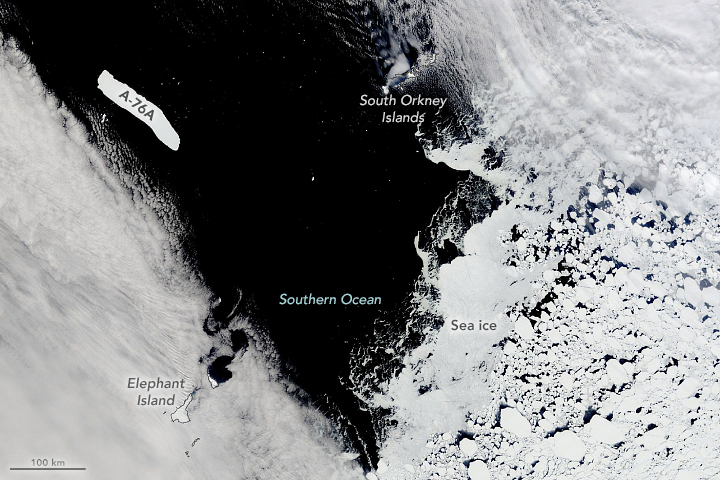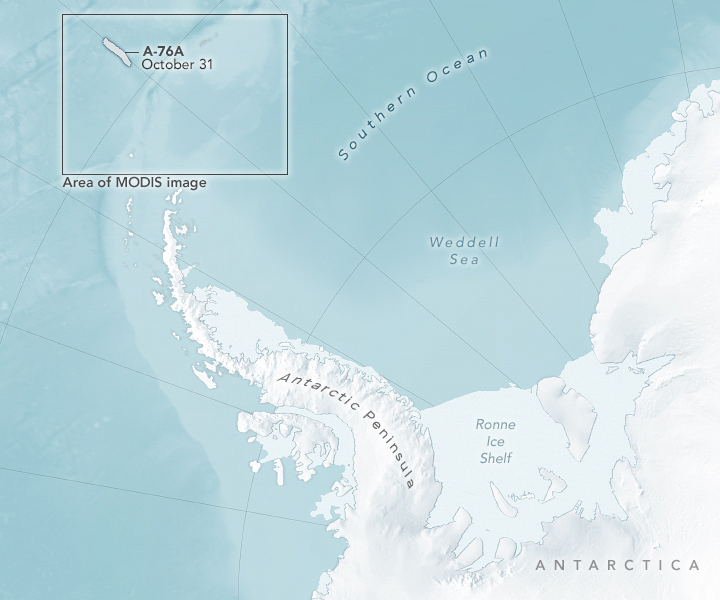Meet Antarctic Iceberg A-76 A – the World’s Largest Iceberg
Written by Prarthana Sheopuri. Managing Editor, I Kid You Not.
How big is A-76 A?
Written by Prarthana Sheopuri. Managing Editor, I Kid You Not.
NASA (the American space agency – National Aeronautics and Space Agency), has shown a new satellite image of an Antarctic iceberg named,
A-76A.

earthobservatory.nasa.go
A-76 is super special, let’s find out why
A-76 A is actually the biggest remaining piece of what was once the largest floating iceberg on Earth – the size of the American state of Rhode Island, A-76, fractured into three chunks: A-76A, A-76B, and A-76C.
In October 2022, NASA’s satellite spotted the A-76A moving into the stormy Drake Passage which lies between Antarctica and South America.

How big is A-76 A?
In June 2021, The US National Ice Center reported that the iceberg is 135 kilometers long and 26 kilometers wide.
The total area of the iceberg is about twice the size of the city of London.
Iceberg A-76 broke from Antarctica’s Ronne Ice Shelf in May 2021. The iceberg lost its status (position) as the largest iceberg when it broke into three pieces within a month.
A-76A now drifts nearly 2,000 kilometers away in the Drake Passage.
What is the Drake Passage?
The Drake Passage is a body of water that’s about 600 miles (that’s about 1000 km) wide. Known for its rough waters and icy winds, the Drake Passage connects the Atlantic and Pacific oceans between South America’s Cape Horn and Antarctica’s South Shetland Islands.
It’s named after a famous English seaman Sir Francis Drake – although he wasn’t the one to discover it. The first person to go through this treacherous passage was a Flemish explorer named Willem Schouten in 1616.
Back to the Iceberg…
Where is the iceberg A-76 A moving currently?
A-76 A now floats in the Weddell Sea (part of the Southern Ocean). After this, most icebergs often move north toward the equator and as the temperature is high there they quickly melt in the warm water.

Quick facts about Icebergs
Icebergs are broken pieces of ice that were earlier a part of glaciers. This process is called calving. Though icebergs float in the ocean, they are not made of saltwater and are actually made of frozen freshwater.Glaciers are made from compacted snow, which is freshwater. In fact, about 3/4th of Earth’s freshwater is stored in glaciers. Glacier ice is the largest reservoir (storage) of freshwater on Earth!
Differences between an Iceberg and a Glacier
A glacier is a massive pile of ice positioned on the land, whereas an Iceberg is a huge stack of ice floating in the water. Glaciers get bigger with time as they are on land, whereas icebergs melt away with time as they are always floating in the water.
Did you know..
Have you heard the phrase ‘tip of the iceberg’? It means only part of an idea or a problem is known and the majority is unknown. Well, it comes from the fact that only one-eighth of an iceberg is visible above the water. The rest of the iceberg lies below the surface of the water.

The portion of the iceberg below the water is dangerous as the sharp, hidden ice can easily tear a hole in the bottom of a ship.
An interesting fact
A part of the North Atlantic is known as Iceberg Alley, an alley is actually a passage, because of the high number of icebergs that find their way there. It is located close to Newfoundland, Canada.
One of the most well-known tragedies involving an iceberg was the Titanic.
Here’s a quick word on what happened
In 1912, a large British ocean liner, named Titanic, on its way to the city of New York, struck an iceberg and sank in Iceberg Alley, which lead to the death of more than 1,500 people.
Soon after the Titanic sank, an International Ice Patrol was established to track icebergs and warn ships which continues to this day. Global positioning system (GPS) technology is used to help locate icebergs along with satellites that are used to track the world’s ice.
What happens eventually to the icebergs?
Icebergs that move into warmer waters melt. Scientists estimate the lifespan ( lifetime) of an iceberg( first snowfall on a glacier to final melting in the ocean) to be around 3,000 years.
You May Also Like:
Who Are The Sentinelese: A Tribe Living in Isolation?
All You Need to Know About The Bermuda Triangle
Is the Loch Ness Monster Real? All You Need to Know.

Better Your Child’s G.K. In 3 Minutes – Get This Free Newsletter
Get fun facts, simple and easy news, quizzes, and lots of other interesting things to read in your mailbox – for free! It’s what we call GK-on-the-go!
I Kid You Not now has a large readership across India and also parts of the world. If you want to write for us, you can submit your story here. You can also apply to become a news anchor. Apply here



Comments